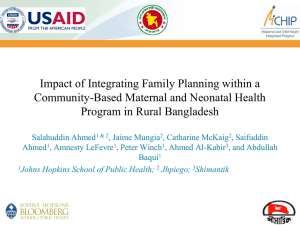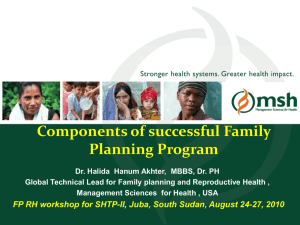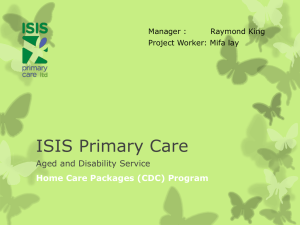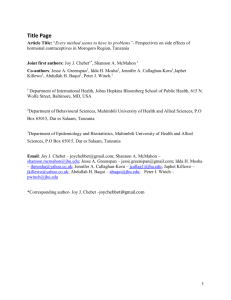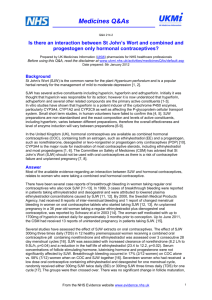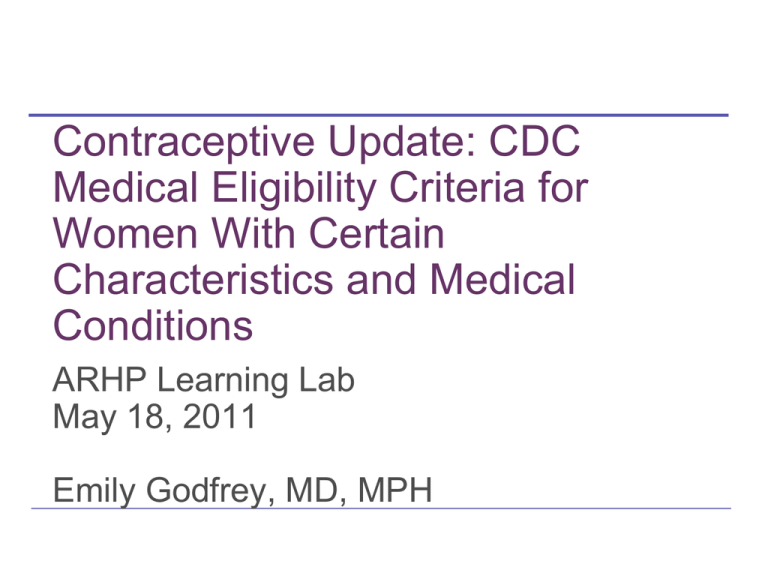
Contraceptive Update: CDC
Medical Eligibility Criteria for
Women With Certain
Characteristics and Medical
Conditions
ARHP Learning Lab
May 18, 2011
Emily Godfrey, MD, MPH
Expert Medical Advisory Committee
Melanie Deal, WHNP
David Turok, MD
Student Health Services, SF
State University
San Francisco, CA
University of Utah, Dept. of
Ob/Gyn
Salt Lake City, UT
David Grimes, MD
Susan Wysocki,
WHNP-BC, FAANP
University of North Carolina
School of Medicine
Chapel Hill, North Carolina
National Association of NPs
in Women’s Health
Washington, DC
Learning Objectives
• List the 4 levels in the numeric scheme
described in the US Medical Eligibility Criteria
for Contraceptive Use, 2010
• Explain the application of the numeric scheme
to prescriptive practices for women with comorbid conditions
• Describe the risks and benefits of the different
contraceptive methods against the risks of
pregnancy in women with health-related
concerns
Unplanned pregnancy – U.S.
Unintended Pregnancy
6.4 million pregnancies
Fetal Loss
Unintended (49%)
7%
Abortion
Intended
20%
1.2 million
51%
22%
Birth
1.4 million
Finer LB, et al. Persp Sex Reprod Health. 2006.
Goals to Address Unintended
Pregnancy
• Healthy People 2020
▪
▪
Increase proportion of pregnancies that are intended
▫ 51% 56%
Reduce proportion of females experiencing pregnancy despite
reversible contraception use
▫ 12.4% 9.9%
• CDC Winnable Battles
▪
▪
▪
Public health priorities with large-scale impact on health and with
known, effective strategies to intervene
To identify optimal strategies and to rally resources and partnerships
to accelerate a measurable impact on health
Prevention of teen pregnancy is one of the 6 winnable battles
http://healthypeople.gov/2020/
http://www.cdc.gov/winnablebattles/teenpregnancy/index.html
Typical Effectiveness of Contraception
Long acting reversible contraceptives (LARCs)
Tier 1
Tier 2
Tier 3
Tier 4
Adapted from: WHO. Family Planning: A Global Handbook
Contraception Use
Mosher, W et al. 2010.
Improving Contraception Access
• Improve access to and use of the most effective
contraceptives
• Address barriers to use of Long Acting Reversible
Contraceptives (LARC)
• Educate Providers
▪
▪
Ensure dissemination of US MEC
Recommend that young women and nulliparous may be eligible to use
LARC methods
• Increase interest and acceptance through education and
social marketing
• Address cost barriers to ensure publically funded services
include LARC
http://www.cdc.gov/winnablebattles/teenpregnancy/index.html
US Medical Eligibility Criteria for
Contraceptive Use
• CDC published criteria in June ‘10
• Based on the 4th edition of the World Health
Organization guidelines from ‘09
• Adapted for US women by panel of experts
and CDC
• Recommendations for the use of specific
contraceptives by women who have
particular characteristics/medical conditions
http://www.cdc.gov/reproductivehealth/UnintendedPregnancy/USMEC.htm
WHOCDC US MEC
Existing WHO guidance
• Breastfeeding and hormonal methods
• Valvular heart disease and IUDs
• Postpartum IUD insertion
• Ovarian cancer and IUDs
• Fibroids and IUDs
• DVT/PE and hormonal methods and IUDs
WHOCDC US MEC
New medical conditions
• Rheumatoid arthritis
• Endometrial hyperplasia
• Inflammatory bowel disease
• Bariatric surgery
• Solid organ transplantation
• Peripartum cardiomyopathy
US Medical Eligibility Criteria for
Contraceptive Use
US Medical Eligibility Criteria:
Organization
• Criteria are organized according to:
– Contraceptive method
– Patient characteristics (age, smoking status, etc.)
– Preexisting conditions (hypertension, epilepsy, etc.)
• Criteria use a numeric scheme to provide the
recommendations for contraceptives being used
for contraceptive purposes only, not for treatment
of medical conditions
http://www.cdc.gov/mmwr/pdf/rr/rr5904.pdf
US Medical Eligibility Criteria:
Categories
1
2
No restriction for the use of the contraceptive method
for a woman with that medical condition
Advantages of using the method generally outweigh
the theoretical or proven risks
3
Theoretical or proven risks of the method usually
outweigh the advantages – or that there are no other
methods that are available or acceptable to the
women with that medical condition
4
Unacceptable health risk if the contraceptive method
is used by a woman with that medical condition
http://www.cdc.gov/mmwr/pdf/rr/rr5904.pdf
US Medical Eligibility Criteria: ↑ Risk
for Adverse Health Events
Conditions Associated w/ ↑ Risk for Adverse Heath Events as a Result of Unintended Pregnancy
Malignant liver tumors (hepatoma) and
hepatocellular carcinoma of the liver
Breast cancer
Should consider longacting, highly-effective
contraception for these
patients
Complicated valvular heart disease
Peripartum cardiomyopathy
Diabetes: insulin dependent; with
nephropathy/retinopathy/neuropathy or other vascular disease;
or of >20 years’ duration
Schistosomiasis with fibrosis of the liver
Endometrial or ovarian cancer
Severe (decompensated) cirrhosis
Epilepsy
Sickle cell disease
Hypertension (systolic > 160 mm Hg or diastolic > 100 mm Hg)
Solid organ transplantation within the past
2 years
History of bariatric surgery within past 2 years
Stroke
HIV/AIDS
Systemic lupus erythematosus
Ischemic heart disease
Thrombogenic mutations
Malignant gestational trophoblastic disease
Tuberculosis
http://www.cdc.gov/mmwr/pdf/rr/rr5904.pdf
Pregnancy-Related Mortality
• Increase in pregnancy-related mortality, 1998-2005
▪
De-identified death certificates of women who died during
or within 1 year of pregnancy
▪
Matched birth or fetal death certificates
• Pregnancy-related mortality
▪
14.5 per 100,000 live births
▫ African American, 3-4 times greater risk
▫ Decreased deaths due to hemorrhage and hypertensive
disorders
▫ Increased deaths due to medical conditions, especially
CVD
Berg, CJ et al. Obstet Gynecol. 2010;116:1302-1309.
Case Presentation 1
• Which hormonal
methods are safe for
her to use?
A.
B.
C.
Combined hormonal
methods only
Progestin-only
methods only
Any hormonal method
Breastfeeding
Case Presentation 1
• Which hormonal
methods are safe for
her to use?
A.
B.
C.
Combined hormonal
methods only
Progestin-only
methods only
Any hormonal method
Case Presentation 2
• Is this method safe
for her?
A.
B.
Yes
No
Inflammatory Bowel Disease
Case Presentation 2
• Is this method safe
for her?
A.
B.
Yes (Category 1)
No
Case Presentation 3
• What do you need to
know before deciding
whether to recommend
this method?
A.
B.
C.
How much weight has
she lost?
What type of surgery did
she have?
What pill formulation did
she use previously?
Bariatric surgery
• Most effective weight loss treatment for
morbid obesity
• From 1998 to 2005, incidence increased
800%
• Women account for 83% of procedures
among reproductive age (ages 18-45)
Types of Bariatric surgery
• Restrictive procedures:
▪
▪
Decrease storage capacity of stomach
Ex: vertical banded gastroplasty, laparoscopic
adjustable gastric band, laparoscopic sleeve
gastrectomy
• Malabsorptive procedures:
▪
▪
Decrease absorption of nutrients and calories by
shortening functional length of small intestine
Ex: Roux-en-Y gastric bypass (most common in
US), biliopancreatic diversion
Bariatric Surgery
• Consensus: Pregnancy should be avoided
for 12-24 months after surgery
Paulen, ME et al. Contraception 82 (2010) 86-94.
History of Bariatric Surgery
Case Presentation 3
• What do you need to
know before deciding
whether to recommend
this method?
A.
B.
C.
How much weight has
she lost?
What type of surgery did
she have?
What pill formulation did
she use previously?
Next Steps
• Work with partners:
▪
▪
dissemination
implementation
• Keeping guidance up to date
Updated Guidance from WHO
September 2010
What increased risk is posed by use of
Combined Hormonal Contraceptives?
• No data specifically delineates risk of CHC
use during the postpartum
• Baseline risk of VTE in non-pregnant, nonpostpartum women:
▪
2.4-10/10,000 WY
• CHC use increases risk:
▪
3-7 fold
• Risk most pronounced in the first year of use
Previous WHO MEC
recommendation
CHCs in postpartum women
< 21 days postpartum
3
≥ 21 days postpartum
1
CHCs for women during the postpartum period
Condition
Recommendation
Clarification
Postpartum
a. < 21 days
Without other risk factors
for VTE
3
With other risk factors for
VTE
3/4
The category should be
assessed according to the
number, severity, and
combination of VTE risk factors
present.
b. > 21 days to 42 days
Without other risk factors
for VTE
2
With other risk factors for
VTE
2/3
c. > 42 days
1
The category should be
assessed according to the
number, severity, and
combination of VTE risk factors
present.
US MEC-Postpartum period
• New evidence
• Updated recommendations from WHO
▪
▪
▪
CDC held consultation in Jan 2011
Substantial increased risk in early weeks
postpartum with no benefit
Multiple risk factors
• Access issues
• Safety of other contraceptive methods
• Will be published as MMWR
Next Steps
• Work with partners:
▪
▪
dissemination
implementation
• Keeping guidance up to date
• Research gaps
• US adaptation of WHO Selected Practice
Recommendations for Contraceptive Use
Resources
• US MEC published in CDC’s Morbidity and
Mortality Weekly Report (MMWR):
▪
http://www.cdc.gov/mmwr/preview/mmwrhtml/rr5904a1.ht
m?s_cid=rr5904a1_w
• CDC evidence-based family planning guidance
documents:
▪
http://www.cdc.gov/reproductivehealth/UnintendedPregna
ncy/USMEC.htm
• WHO evidence-based family planning guidance
documents:
▪
http://www.who.int/reproductivehealth/publications/family_
planning/en/index.html
Additional Resources
• Association of Reproductive Health
Professionals (ARHP)
▪
www.arhp.org
• National Association of Nurse Practitioners in
Women’s Health (NPWH)
▪
www.npwh.org



